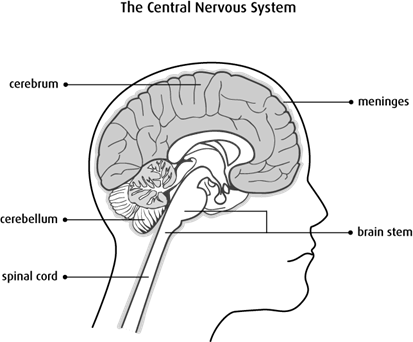What is a brain or spinal cord tumour?
A brain tumour starts in the cells of the brain. A spinal cord tumour starts in the cells of the spinal cord. Together, the brain and spinal cord form the central nervous system (CNS). The brain is the control centre of your body. It is a soft mass of nerve tissue protected by a bony covering called the skull. The spinal cord runs through the spine. It contains nerves that send information between the brain and the rest of the body.

Cells in the brain or spinal cord sometimes change and no longer grow or behave normally. These changes may lead to non-cancerous (benign) conditions such as brain or spinal cord cysts. Cells in the brain and spinal cord can also change and form tumours. All brain and spinal cord tumours can cause severe or life-threatening symptoms.
Brain and spinal cord tumours are classified based on their grade. The grade of a tumour tells your healthcare team how quickly it is growing and how likely it is to spread.
Low-grade (non-cancerous) tumours grow slowly. They don’t usually grow into surrounding tissues or spread to other areas of the brain or spinal cord. Some low-grade tumours may develop into high-grade tumours.
High-grade (cancerous) tumours grow quickly. They can grow into nearby tissues and spread to other parts of the brain or spinal cord. Cancerous tumours that start in the brain and spinal cord rarely spread outside the CNS.
Types of brain and spinal cord tumours
Glioma is a general term for a group of tumours that start in glial cells that are the supportive cells of the brain or spinal cord. They are the most common type of primary brain tumours in adults and account for most of the cancerous (high-grade) tumours of the CNS. There are different types of gliomas, including astrocytoma, oligodendroglioma and ependymomas.
Brain and spinal cord tumours can also start in the cells of the meninges. The meninges are the membranes that cover the brain and spinal cord. These tumours are called meningiomas. Low-grade meningiomas are the most common type of non-cancerous brain and spinal cord tumour in adults.
There are many less common types of brain and spinal cord tumours including acoustic neuroma, craniopharyngioma, hemangioblastoma and primary central nervous system lymphoma.
Some types of brain and spinal cord tumours are more common in children and others are more common in adults. Find out more about brain and spinal cord tumours in children.
Brain metastasis
When a tumour starts in brain cells, it is called a primary brain tumour. Other types of cancer can spread to the brain, but this is not the same disease as a primary brain tumour. Cancer that starts in another part of the body and spreads to the brain is called brain metastasis or a secondary tumour. It is not treated in the same way as a primary brain tumour. Find out more about brain metastasis.
